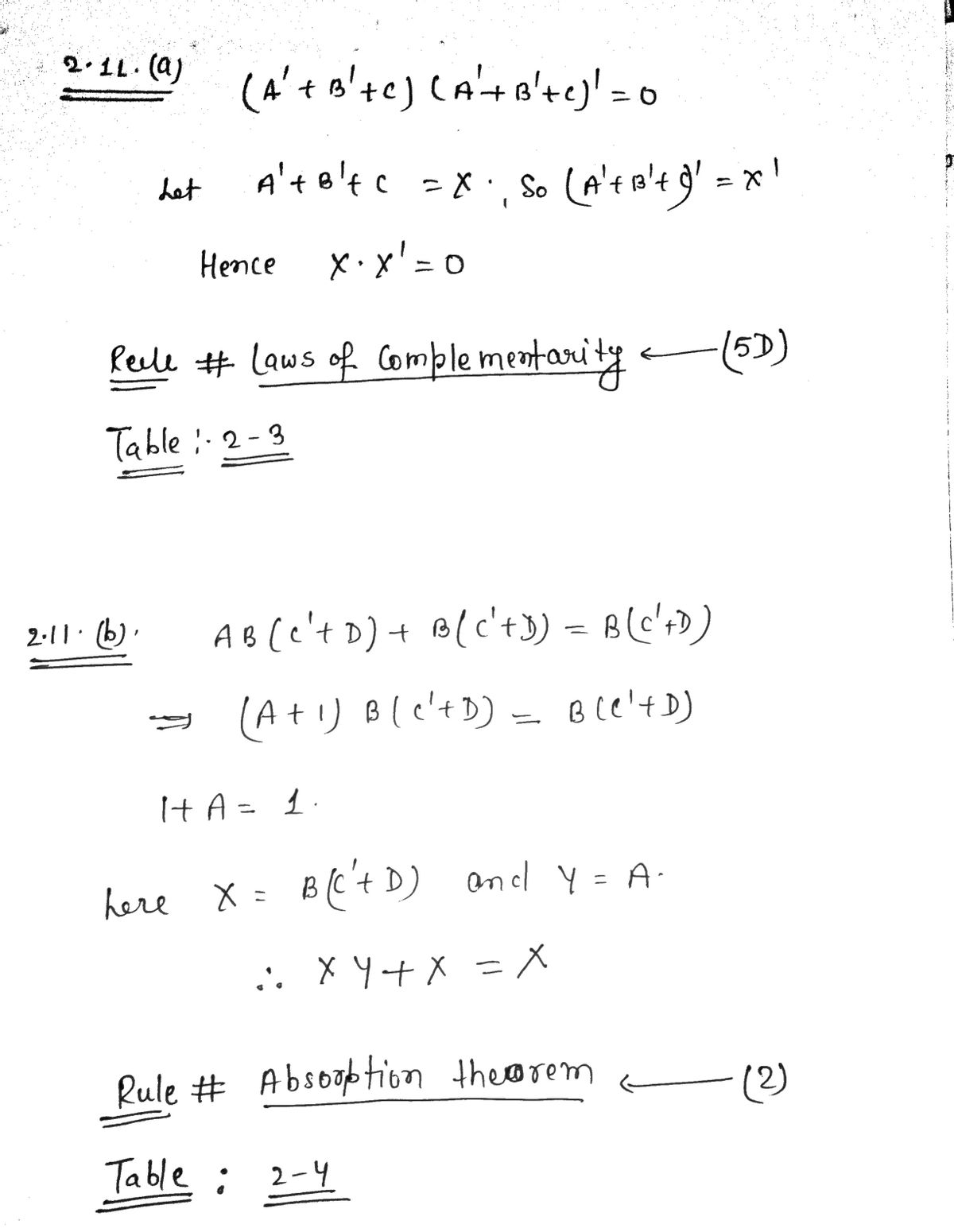Since the answer is given below, only state the law # used from the given Tables: 2.11 (a) (A' + B' + C)(A' + B' + C)'= 0 2.11 (b) AB(C' + D) + B(C' + D) = B(C' + D) Rule # Table: Rule # Table: 2.11 (c) AB + (C' + D)(AB)' = AB + C' + D 2.11 (d) (A'BF + CD')(A'BF + CEG) = A'BF + CD'EG Rule # Table: Rule # Table:
Since the answer is given below, only state the law # used from the given Tables: 2.11 (a) (A' + B' + C)(A' + B' + C)'= 0 2.11 (b) AB(C' + D) + B(C' + D) = B(C' + D) Rule # Table: Rule # Table: 2.11 (c) AB + (C' + D)(AB)' = AB + C' + D 2.11 (d) (A'BF + CD')(A'BF + CEG) = A'BF + CD'EG Rule # Table: Rule # Table:
Introductory Circuit Analysis (13th Edition)
13th Edition
ISBN:9780133923605
Author:Robert L. Boylestad
Publisher:Robert L. Boylestad
Chapter1: Introduction
Section: Chapter Questions
Problem 1P: Visit your local library (at school or home) and describe the extent to which it provides literature...
Related questions
Question
PLEASE HELP with this question!

Transcribed Image Text:Since the answer is given below, only state the law # used from the given Tables:
2.11 (a) (A' + B' + C)(A' + B'+ C)'= 0
2.11 (b) AB(C' + D) + B(C' + D) = B(C' + D)
Rule #
Table:
Rule #
_Table:
2.11 (c) AB + (C' + D)(AB)' = AB + C' + D
2.11 (d) (A'BF + CD')(A'BF + CEG) = A'BF + CD'EG
Rule #
Table:
Rule #
Table:
TABLE 2-3
TABLE 2-4
Operations with 0 and 1:
1. X + 0 = X
2. X + 1 = 1
Uniting theorems:
1. XY + XY' =X
1D. X ·1 = X
1D. (X + Y)(X + Y') = X
2D. X · 0 = 0
Absorption theorems:
2. X + XY = X
Idempotent laws:
2D. X(X + Y) = X
3. X + X = X
3D. X · X = X
Elimination theorems:
Involution law:
3. X + X'Y = X + Y
3D. X(X' + Y) = XY
4. (X')' = X
Duality:
4. (X + Y + Z + . -)º = XYZ. .. 4D. (XYZ. .. )º = X + Y + Z + · ..
Laws of complementarity:
5. X + X' = 1
5D. X · X' = 0
multiplying out and factoring:
5. (X + Y)(X' +Z) = XZ + X'Y
Commutative laws:
5D. XY + X'Z = (X + Z)(X' + Y)
6. X + Y = Y+ X.
6D. XY = YX
Consensus theorems:
Associative laws:
6. XY + YZ + X'Z = XY + X'z
6D.(X + Y)(Y + Z)(X' + Z) = (X+ Y)(X' + Z)
7. (X + Y) + Z =X + (Y + Z) 7D. (XY)Z = X(YZ)
= XYZ = X + Y+Z
Distributive laws:
8. X(Y + Z) = XY + XZ
8D. X + YZ = (X + Y)(X + Z)
DeMorgan's laws:
9. (X + Y)' = X'Y'
9D. (XY)' = X' + Y'
Expert Solution
Step 1

Trending now
This is a popular solution!
Step by step
Solved in 2 steps with 2 images

Knowledge Booster
Learn more about
Need a deep-dive on the concept behind this application? Look no further. Learn more about this topic, electrical-engineering and related others by exploring similar questions and additional content below.Recommended textbooks for you

Introductory Circuit Analysis (13th Edition)
Electrical Engineering
ISBN:
9780133923605
Author:
Robert L. Boylestad
Publisher:
PEARSON

Delmar's Standard Textbook Of Electricity
Electrical Engineering
ISBN:
9781337900348
Author:
Stephen L. Herman
Publisher:
Cengage Learning

Programmable Logic Controllers
Electrical Engineering
ISBN:
9780073373843
Author:
Frank D. Petruzella
Publisher:
McGraw-Hill Education

Introductory Circuit Analysis (13th Edition)
Electrical Engineering
ISBN:
9780133923605
Author:
Robert L. Boylestad
Publisher:
PEARSON

Delmar's Standard Textbook Of Electricity
Electrical Engineering
ISBN:
9781337900348
Author:
Stephen L. Herman
Publisher:
Cengage Learning

Programmable Logic Controllers
Electrical Engineering
ISBN:
9780073373843
Author:
Frank D. Petruzella
Publisher:
McGraw-Hill Education

Fundamentals of Electric Circuits
Electrical Engineering
ISBN:
9780078028229
Author:
Charles K Alexander, Matthew Sadiku
Publisher:
McGraw-Hill Education

Electric Circuits. (11th Edition)
Electrical Engineering
ISBN:
9780134746968
Author:
James W. Nilsson, Susan Riedel
Publisher:
PEARSON

Engineering Electromagnetics
Electrical Engineering
ISBN:
9780078028151
Author:
Hayt, William H. (william Hart), Jr, BUCK, John A.
Publisher:
Mcgraw-hill Education,